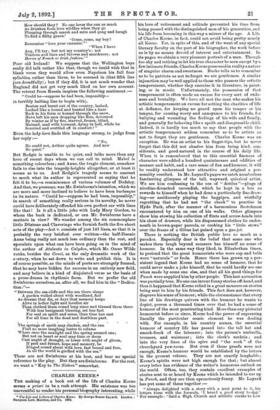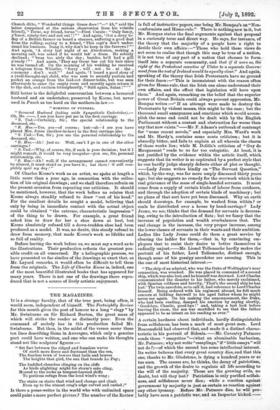CHARLES KEENE.*
THE making of a book out of the life of Charles Keene seems a priori to be a rash attempt. His existence was too uneventful to render his personal biography interesting, while The We and Letters of Charles Keene. By George Some Layard. London : Sampson Low, Marston, and Co. 1282.
his love of retirement and solitude prevented his time from being passed with the distinguished men of his generation, and his life from becoming in this way a mirror of the age. A Life of Charles Keene, in fact, could not avoid being pretty nearly all Keene. Yet, in spite of this, and of the want of any special literary faculty on the part of his biographer, the work before us is by no means devoid of interest and entertainment. In its pages we obtain a very pleasant portrait of a man. Though too shy and retiring to let his true character be seen except by a few intimate friends, Charles Keene possessed in reality a nature of singular charm and sweetness. Burke tells us to remember so to be patriots as not to forget we are gentlemen. A similar injunction may be well applied to those who possess the artistic temperament, whether they exercise it in literature, in paint- ing, or in music. Unfortunately, the possession of that temperament is often made an excuse for every sort of rude- ness and brutality. We have all met the man who makes his artistic temperament an excuse for setting the charities of life at defiance, for keeping no guard upon his temper or his tongue, for causing worry and annoyance to his friends, for bullying and wounding the feelings of his wife and family, and generally for behaving like a spoilt and disagreeable child. Indeed, it is hardly too much to say that people with the artistic temperament seldom remember so to be artists as not to forget they are gentlemen. Charles Keene was an exception. He was an artist to his finger-tips, but he never forgot that this did not absolve him from being kind, con- siderate, and good-natured in the course of his daily life. When it is remembered that to this essential fineness of character were added a hundred quaintnesses and oddities of manner and habit, and a rare sense of fun and humour, it will be readily understood how attractive and original a per- sonality resulted. In Mr. Layard's pages we catch numberless fascinating glimpses of the tall, wayward, quizzical artist. We see him confessing to the use of " dottles "—plugs of nicotine-drenched cavendish, which he kept in a box as rewards to himself when he had done a particularly fine draw- ing—or assiduously playing the bagpipes, and wistfully regretting that he had not "the cheek" to practise in Hyde Park, after the manner of a harmonious Scotchman encountered by him on one of his walks. Other glimpses show him stowing his collection of flints and arrow-heads into his chest of drawers, while his dispossessed clothes lie under- neath in brown-paper parcels, or cooking his "little stews" over the frame of a Gibus hat poised upon a gas-jet.
There is nothing the British public love so much as a paradox. Especially dear is the belief that some one who makes them laugh beyond measure has himself no sense of humour. In the same way they liked, in Elizabethan times, to pretend that the great httmourists who wore cap and bells were " naturals " or fools. Hence there has grown up a per- sistent legend that Keene had no sense of humour, that he could never make a joke himself, that he could hardly see one when made by some one else, and that all his good things for Punch were supplied him by other people. This last accusation was partially true. No one can invent funny stories off-hand, and thus it happened that Keene relied in a great measure on stories being sent to him by his friends. This fact does not, however, disprove his sense of humour; while the circumstance that every line of his drawings quivers with the humour he wants to depict, proves a thousand times over that he had a sense of humour of the most penetrating kind. More than any pictorial humourist before or since, Keene had the power of expressing lineally the particular comic element he was dealing with. For example, in his country scenes, the essential humour of country life has passed into the tall hat and smock-frock of the labourer; into the parson's umbrella, trousers, and waistcoat ; into the clerk's necktie ; and into the very lines of the spire and "the cock" of the churchyard yew-trees. But even if these proofs were not enough, Keene's humour would be established by the letters in the present volume. They are not exactly laughable ; Keene's spirits were not high enough for that; but almost every letter has evidence of the writer's humorous outlook on the world. Often, too, they contain excellent examples of stories sent to or heard by Keene which he intended to use up in Punch, and they are then uproariously funny. Mr. Layard has put some of these together :—
" Always delighted with a story with a neat point to it, his lettprs teem with the formula, heard a good story to-day.' For example : Said a High.. Church and athletic curate to Low
Church ditto, "Wonderful things Grace does !"—" Ah," said the latter (surprised at the serious observation from his volatile friend), " Terue, my friend, terup."—First Curate "Only fancy, y'know, ninety-two and not out ! ! " ' And again, Got a story to- day of a British farmer on board a steamer, suffering a good deal from the rolling, saying to a friend, "This capt'n don't under- stand his business. Dang it, why don't he keep in the furrows ? " And again, 'A story last night of an Aberdonian, making a morning call, was asked if he would tak' a dram. He soberly declined ; "I-was too airly the day; besides, he'd had a gill a'ready ! " ' And again, They say Oscar has cut his hair since he was turned off. On the morning of his wedding he received a telegram from Whistler, "Sorry . will . not . be . at . the . ceremony . don't . wait." ' And again, heard a good story of a (well-brought-up) child, who was seen to secretly purloin and pocket an orange from the laid-out dinner-table, but was seen afterwards to enter the empty room and secretly again return it to the dish, and exclaim triumphantly, "Sold again, Satan !" " Still better is the delightful conversation between a bereaved husband and an undertaker, preserved by Keene, but never used in Punch as too hard on the mothers-in-law
MORNING OF FUNERAL
"Bereaved Husband (taking aside Sympathetic Undertaker).— Oh, Mr. —, I see you have put me in the first carriage.
"s. Und.—Certainly, Sir ; the special relationship to the deceased, etc.
"B. Hus.—Yes, yes—of course ; but—ah—I see you have placed Mrs. Jones (mother-in-law) in the first carriage also "S. Und.—Yes, Sir; you see the personal relationship to the deceased, etc.
"B. Hus.—Ah just so. Well, can't I go in one of the other carriages ?
"S. Und.—Why, of course, Sir, if such is your decision ; but if I might remark, it would be very irregular—you see, Sir, personal relationship, etc.
"B. Hus.—Ah ! well, if the arrangement cannot conveniently be altered, it must stand as you have it ; but there ! it will com- pletely spoil my day ! "
Of Charles Keene's work as an artist, we spoke at length a little more than a, year ago, in connection with the collec- tion of his original drawings; and we shall therefore refrain on the present occasion from repeating our criticism. It should be mentioned, however, that the work before us relates that Keene always steadily refused to draw "out of his head." For the smallest details he sought a model, believing that only by being in immediate contact with the actual object could be obtained "the extreme, characteristic impression" of the thing to be drawn. For example, a great friend asked him to draw for her a shoe down at heel, but Keene absolutely refused till a down-trodden shoe had been produced as a model. It was, no doubt, this steady refusal to draw from memory, that made Keene's work so lifelike and so fall of reality.
Before leaving the work before us, we must say a word as to the illustrations. Their production reflects the greatest pos- sible credit on all concerned. By a heliographic process, we have presented us facsimiles of the drawings so exact that, as Mr. Layaxd remarks, it would often be difficult to tell them from the originals. The Life of Charles Keene is, indeed, one of the most beautiful illustrated books that has appeared for many years. There is not one of the drawings there repro- duced that is not a source of lively artistic enjoyment.











































 Previous page
Previous page